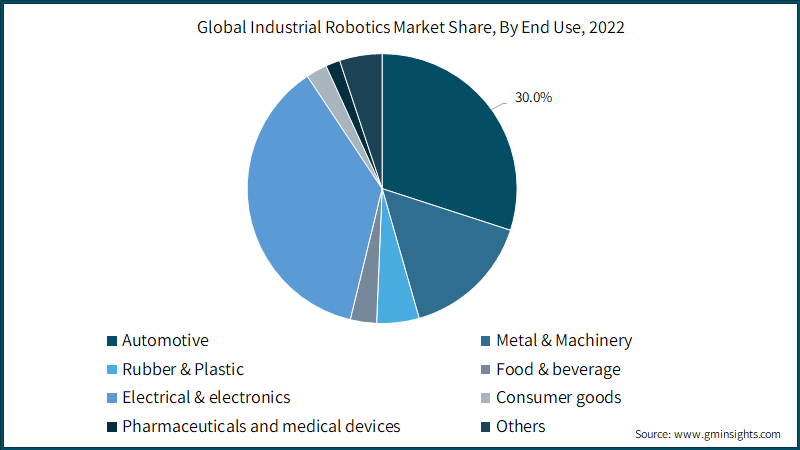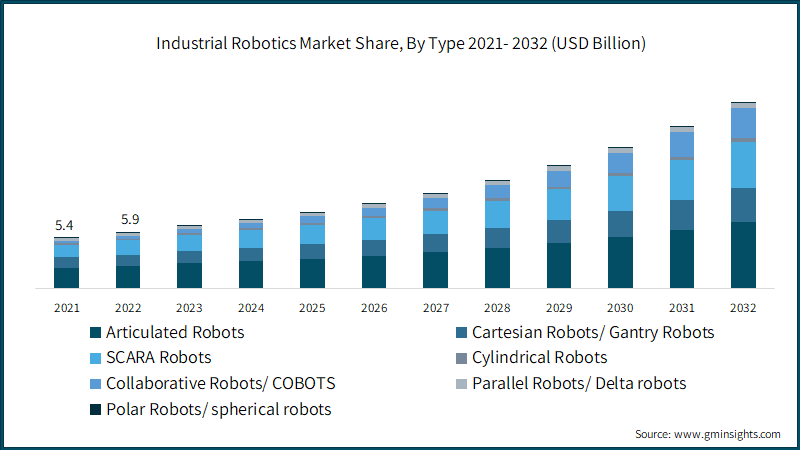Home > Semiconductors & Electronics > Automation > Robotics > Industrial Robotics Market
Industrial Robotics Market Analysis
- Report ID: GMI1729
- Published Date: Sep 2023
- Report Format: PDF
Industrial Robotics Market Analysis
Based on type, the industrial robotics market is divided into articulated robots, cartesian robots/ gantry robots, scara robots, cylindrical robots, collaborative robots/ cobots, parallel robots/ delta robots, polar robots/ spherical robots. The Collaborative Robots/ COBOTS segment is expected to grow at a highest CAGR of over 20% from 2023 to 2032. Cobots are designed to work alongside human workers in a shared workspace. This collaboration allows them to perform tasks that require human judgment, dexterity, and adaptability, making them ideal for industries where close interactions between humans and robots is beneficial.
Collaborative robots can assist human workers in performing ergonomically challenging tasks. This helps reduce the risk of repetitive strain injuries and improves the overall worker well-being, making them valuable in industries where manual labor is involved. Collaborative robots are known for their rapid deployment capabilities. They can be easily set up and integrated into existing production lines with minimal disruptions. This agility appeals to industries seeking swift automation solutions to meet the changing demands. For instance, in February 2022, Yaskawa Motoman launched collaborative robots: HC10DTP and HC20DTP. It can be installed by connecting single cables to the manipulator and the controller, resulting in easy setup and reduced expenses for maintenance and spare parts inventory.

Based on end use, the industrial robotics market is segmented into automotive, metal & machinery, rubber & plastic, food & beverage, electrical & electronics, consumer goods, pharmaceuticals and medical devices, others. The Automotive segment held a market share of over 30% in and market revenue of over USD 4 billion in 2022. The shift toward Electric Vehicles (EVs) and Autonomous Vehicles (AVs) requires advanced manufacturing processes. Robots are integral in the production of EV components such as batteries and electric drivetrains. Additionally, the assembly & quality control of AV technologies benefit from robotic precision and consistency, driving the demand for industrial robots in the automotive sector.
Major players are developing robots for EV manufacturing, which is expected to positively influence the industrial robotics market gains in the automotive sector. For instance, in May 2022, ABB launched IRB 5710 and 5720, material handling robots for EV battery production. Both robots can perform a variety of manufacturing tasks such as assembly, machine tending, and material handling. Additionally, it can carry out EV-specific tasks such as picking & placing battery modules, handling parts, and precise assembly. Consumer demand for customized vehicles is increasing. Industrial robots are highly adaptable and can be reprogrammed or reconfigured quickly to accommodate changes in production requirements.

The Asia Pacific region is expected to be the largest industrial robotics market by 2032. The development of smart cities in China, South Korea, and Singapore is driving the need for advanced Industrial robotics to support various IoT applications. The deployment of 5G networks in Asia Pacific is impacting the industry as manufacturers seek switches capable of handling high-speed and low-latency communication. China is actively adopting robots in various industries, aided by government initiatives to upgrade manufacturing capabilities.

